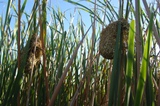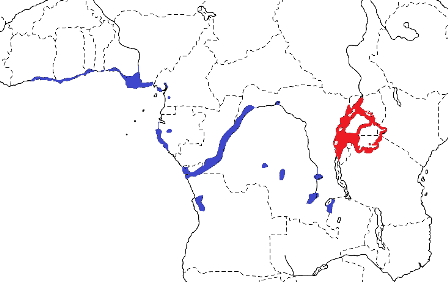Weaver species
Choose different species from drop-down list and press 'Go' button. See Full species list.Slender-billed Weaver Ploceus pelzelni
IUCN: Least concern Discovery: 085Categories: wetland, gum, Ploceus 5: 'Sitagra', white eggs, palm,
News items about species
Discovery
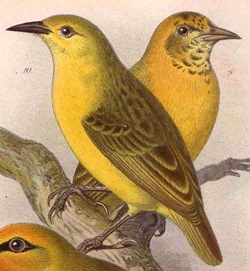
figure from Hartlaub (1887) 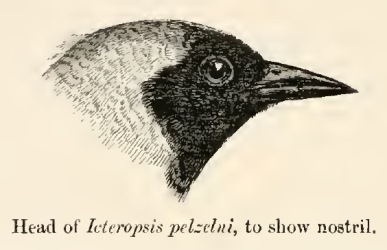
figure from Sharpe (1890) 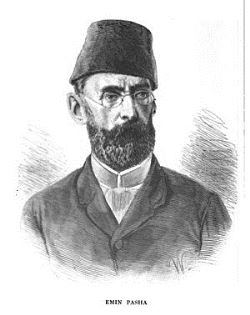
Slender-billed Weaver, from wikipedia 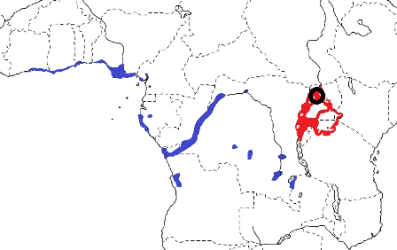
distribution, type locality circled IntroductionThe Slender-billed Weaver was formally described by Karel Johan Gustav Hartlaub, a German physician and ornithologist.The Slender-billed Weaver was collected by Emin Pasha, an Ottoman-German physician, naturalist, and governor. After 1876, Emin made Lado his base for collecting expeditions throughout the region, and here he collected his weaver type, the Cardinal Quelea. In November 1879 Pasha sailed south on a steamer called "Khedive" on the Nile to lake Albert. He devoted his stay at Magungo as far as possible to collecting specimens (including birds, snakes and insects), although he had little ammunition and spirit for preserving specimens. In a letter, Pasha noted that he had found 5 species of weavers in the area, but he only listed the Thick-billed Weaver. Pasha collected 3 specimens of the Slender-billed Weaver in Dec 1879 near Magungo. In 1880 he donated the specimens to Rudolf, Crown Prince of Austria, who passed them on to the Museum in Vienna. One of the specimens was swopped to go to Bremen where Hartlaub recognised it as a new species in 1887. The first illustration of the Slender-billed Weaver was published by Hartlaub (1887), with the description of the species. The next illustration to be published was a line drawing by Sharpe (1890). Scientific citationSitagra pelzelni Hartlaub 1887, Zool. Jahrb. 2, p.343, pl. 14, figs. 9-10, Magungo, Uganda.Meaning of namespelzelni, After August von Pelzeln (1825-1891) Austrian ornithologist, collector, and author.First English namePelzeln's Slender-billed Weaver (Shelley 1905).Alternate namesLittle Slender-billed Black-faced Weaver, Monk weaver, Muanza Slender-billed Weaver, Palm Slender-billed Weaver, Pelzelni's Weaver, Pelzeln's Slender-billed Weaver, West African Weaver.CollectorEmin Pasha.Date collectedNov-Dec 1879.Locality collectedMagungo, Uganda.Type specimensThere are syntypes in Bremen and Vienna Museums. |
The above is based on Weaver Wednesday 2, a weekly series about the discovery of each weaver species.
This species text first appeared as
Weaver Wednesday [202] - Discovery [85]: Slender-billed Weaver on 2016-04-27
1. Basic biology

male, from PHOWN 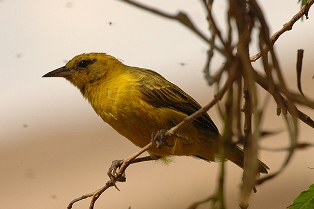
figure from wikipedia
Distribution. The Slender-billed Weaver is found from West Africa across to Lake Victoria. Two subspecies of the Slender-billed Weaver are recognised (see map left, based on Birds of Africa): P. p. pelzelni, in NE DRC, Uganda, SW Kenya, Rwanda, Burundi, and NW Tanzania (see red on map).
Habitat. The Slender-billed Weaver is restricted to wetland areas for breeding, foraging in trees and bushes in adjoining habitats. In western Africa it inhabits mangroves, coastal lagoons, marshlands and ricefields. In southern DRC it occurs in ambatch thickets bordering lakes, and also in gardens and hedges in urban areas. It usually occurs below 1700 m but up to 2350 m in the Ruwenzoris. The Slender-billed Weaver is found singly or in pairs or in flocks. Food. The Slender-billed Weaver feeds mainly on insects, including small caterpillars and ants. Seeds have also been recorded. It forages at all levels in trees. It is agile and often hangs upside down when foraging. The foot structure shows adaptations to a papyrus habitat. Breeding. The Slender-billed Weaver is a monogamous, colonial nester. Colonies are usually in groups of less than 20 nests, but sometimes up to 50, or single nests at about 12 m apart. It may breed alongside mixed colonies of other weaver species. The nest is ball-shaped, tightly woven, without an entrance tunnel or with a very short tunnel, with a porch over the side-top entrance. The nest is made of grass strips or papyrus leaf, and some nests include dead pieces of vine stem. There is no ceiling as in the nests of some weavers. During incubation a sparse lining of very fine strips of grass, palm leaves, feathers or seed-heads may be added.
The nest is attached to papyrus heads, or in trees (thorny twigs or small palms) at a height of 1.5-9m (usually about 3m) above the ground. The nest is built by the male, with the female sometimes helping. Sometimes two nests are built on the same stem, but only one is occupied. Clutch size is 2-3. The eggs are pure white or sometimes pinkish, rarely with fine spots. In Kisangani it breeds all year, but peaks in September. It is parasitized by cuckoos, most likely the Diderick Cuckoo Chrysococcyx caprius. Nests have been robbed by Pied Crows Corvus alba and Senegal Coucals Centropus senegalensis. Old nests of the Slender-billed Weaver may be used by Dusky-blue Flycatchers Muscicapa comitata. |
The above is based on Weaver Wednesday, a weekly series about weaver species.
This species text first appeared as
Weaver Wednesday [41]: Slender-billed Weaver on 2013-03-27
2. Breeding facts
| Pair bond Monogamous, but unclear if long-term pair-bond Breeding season Jul-Aug in Ghana, Jun-Sept in Togo, May-Oct in Nigeria, Jan-Feb, Apr-Jun and Aug-Nov in Cameroon, May in Gabon; in DRCongo, Aug-Sept in NE, Jun-Jul in C region, Nov-Jan in S, possibly in both rainy seasons in Upemba, Oct-Nov and again Jan-Mar, while urban colony at Kisangani nesting all year, with Sept peak; Mar-Oct (mainly Apr-May in Uganda, Mar-Apr in Angola and Feb in Zambia Nest site sited 1.5-9 m (usually c. 3 m) above groud or over water and attached to papyrus heads, palm frond or pendulous thorny branch Nest building built by male, female sometimes assisting Colony size Colonial nester, usually fewer than 20 nests in colony, rarely up to 50; also single nests c. 12 m apart Clutch size 2-3 eggs Egg colour pure white, sometimes pinkish, rarely with fine dark spots Egg size average size 17.5 x 13.5 mm (locality not stated) Incubation incubation either by female alone or by both sexes, period c. 15 days Chicks and nestling period chicks fed by both male md female, no information on duration of nestling period |
Breeding information based on Handbook of the Birds of the World, Vol. 15.
3. Photos of Weaver Nests
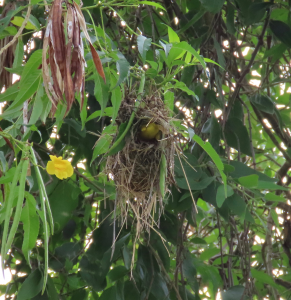 Vm 30411 |  Vm 30396 |  Vm 30395 | 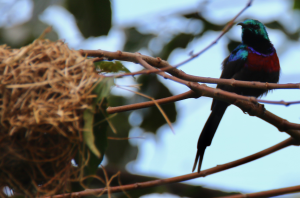 Vm 29947 |  Vm 29945 |  Vm 26343 |
Thumb-nails of most recent PHOWN records - click on one to see its full record
See all PHOWN records for this species here.
PHOWN (Photos of Weaver Nests) provides valuable info on breeding distribution and colony sizes of weavers.
You can contribute by registering and submitting photos at Virtual Museum webpage.
4. Breeding distribution
Google map showing distribution (For species with small ranges you need to zoom in at the correct area to see the range):
yellow blob - range of weaver species; read more about this here.
![]() - PHOWN records with photos
- PHOWN records with photos
![]() - PHOWN records with no photos (Nest Record Cards, other records)
- PHOWN records with no photos (Nest Record Cards, other records)
![]() - Birdpix records
- Birdpix records
![]() - comments on out of range records, or interesting records
- comments on out of range records, or interesting records
![]() - type locality
- type locality
CLICK on the marker on the map to see individual record details.
5. Range changes
Not South African speciesThe above is based on Weaver Wednesday 3, a weekly series about range changes in South African weaver species.
This species text first appeared as
n/a








